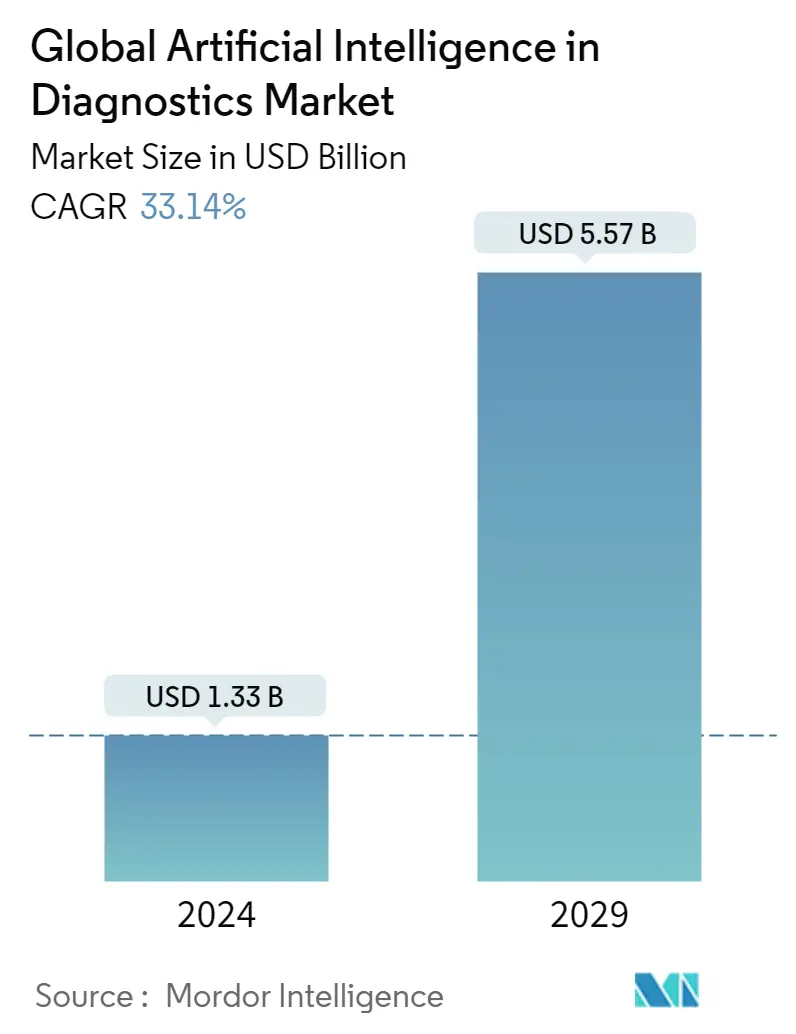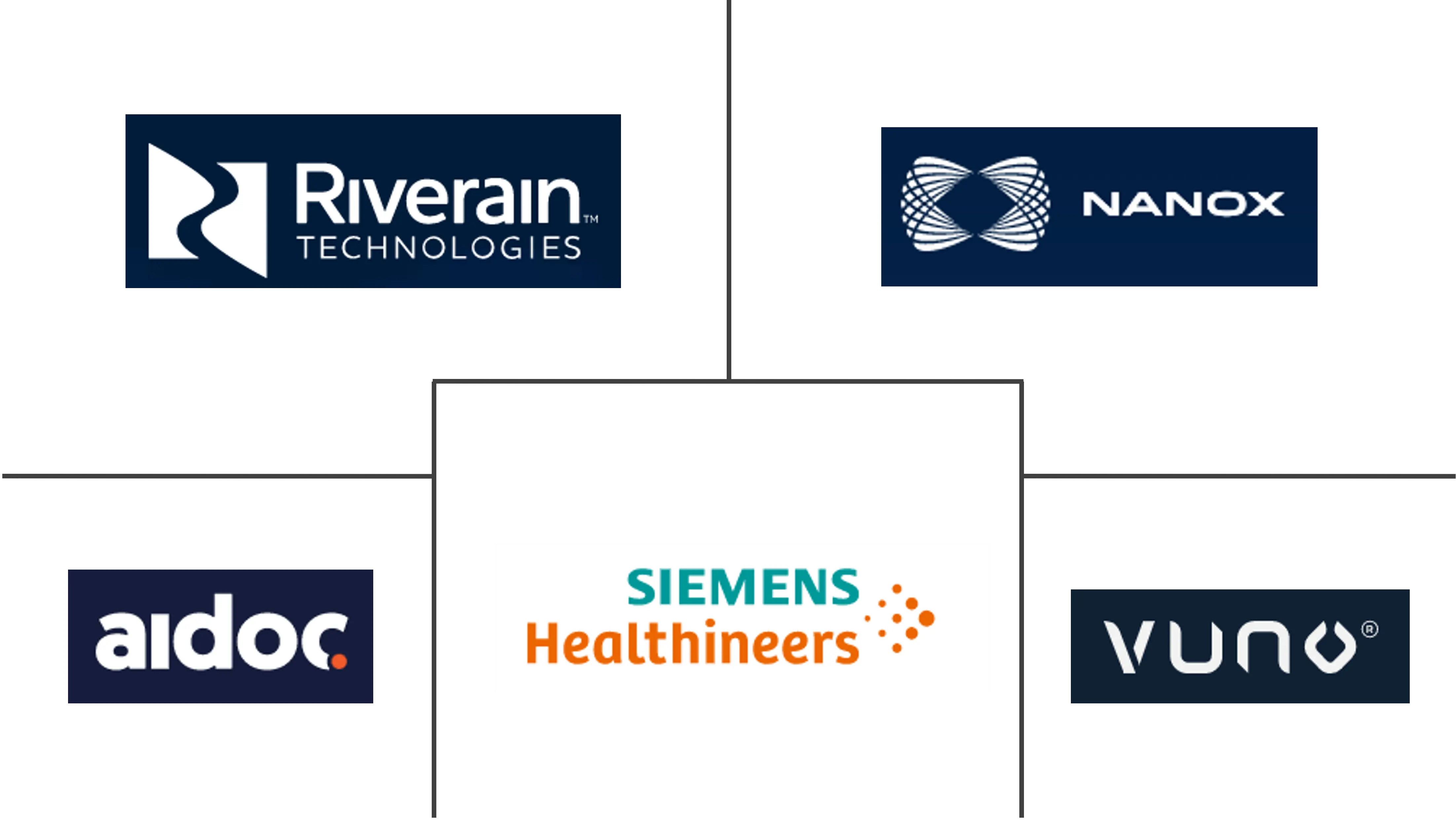Market Size of Global Artificial Intelligence in Diagnostics Industry

| Study Period | 2019 - 2029 |
| Market Size (2024) | USD 1.33 Billion |
| Market Size (2029) | USD 5.57 Billion |
| CAGR (2024 - 2029) | 33.14 % |
| Fastest Growing Market | Asia-Pacific |
| Largest Market | North America |
Major Players
*Disclaimer: Major Players sorted in no particular order |
AI in Diagnostics Market Analysis
The Global Artificial Intelligence in Diagnostics Market size is estimated at USD 1.33 billion in 2024, and is expected to reach USD 5.57 billion by 2029, growing at a CAGR of 33.14% during the forecast period (2024-2029).
The COVID-19 pandemic has significantly impacted the healthcare system, particularly diagnostics. The lockdown measures worldwide decreased public mobility and impacted the diagnostic industry. Moreover, the COVID-19 pandemic not only affected the global economy but also greatly impacted the functioning of general hospital care for non-COVID-19 patients in hospitals across the globe. However, with the increasing demand for diagnostic imaging procedures globally, the demand for implementing artificial intelligence in diagnostics is also increasing. According to the article "Artificial intelligence in the diagnosis of COVID-19: challenges and perspectives," published in April 2021, at different levels of the healthcare system, including diagnosis, artificial intelligence (AI) has been implemented. Particularly during the current pandemic, AI algorithms are crucial for the quick diagnosis of COVID-19 patients.
Additionally, AI tools were employed to handle the pandemic's depth and complexity, from diagnosis to drug development, disease transmission prediction, and population monitoring and surveillance. A study titled "The Role of Artificial Intelligence in Fighting the COVID-19 Pandemic," published in the Journal of "Nature Public Health Emergency Collection" in April 2021, proposed a temporal step method, which includes presenting recent research investigations, examining how AI observes and acts on society and the healthcare system, and reporting various data types. Hence, the deployment of AI tools in diagnosing patients with SARS-CoV-2 played a substantial role throughout the pandemic phase, thereby augmenting the market growth.
Furthermore, factors such as increasing demand for AI tools in the medical imaging field and rising focus on reducing the workload of radiologists, government initiatives to increase the adoption of AI-based technologies, and growth in funding for AI-based start-ups are anticipated to bolster the growth of the market shortly.
Incorporating artificial intelligence into imaging devices may improve the diagnosis, which is expected to aid the overall market growth during the forecast period. For instance, the Journal of the American Medical Association article titled "An Artificial Intelligence-Based Chest X-ray Model on Human Nodule Detection Accuracy from a Multicenter Study," published in December 2021, reported that an artificial intelligence algorithm was associated with improved detection of pulmonary nodules on chest radiographs compared with unaided interpretation for different levels of detection difficulty and readers with different experience. The research articles stated that artificial intelligence could be a promising technology for medical imaging shortly.
Moreover, factors such as increasing funding for AI start-ups globally are increasing the demand for increasing incorporation of AI in the diagnostic imaging modalities. For instance, in March 2022, Qure.ai (Qure), a health-tech business raising USD 40 million in fundraising, employs artificial intelligence (AI) for medical imaging diagnostics. The company further declared that it would utilize the funding to broaden and improve its global presence, particularly in the United States and Europe, and accelerate the development of products for critical care and community diagnostics. Therefore, such fundraising is anticipated to contribute to market growth.
Thus, owing to the aforementioned factors, the market studied is anticipated to grow over the analysis period. However, the lack of a skilled AI workforce and ambiguous regulatory guidelines for medical software is expected to restrain the market's growth.
AI in Diagnostics Industry Segmentation
Artificial intelligence (AI) in medicine uses algorithms and software to approximate human cognition in analyzing complex medical data. Specifically, AI in diagnostics assists healthcare providers in making appropriate treatment decisions for their patients. Artificial Intelligence in Diagnostics Market is segmented By Type (In Vitro Diagnostics, Diagnostic Imaging, and Other Types), Application (Cardiology, Oncology, Neurology, Obstetrics/ Gynecology, and Other Applications), End-User (Hospitals, Diagnostic Imaging Centers, Diagnostic Laboratories, and Other End-Users), and Geography (North America, Europe, Asia-Pacific, Middle East & Africa, and South America). The report also covers the estimated market sizes and trends for 17 countries across major regions globally. The report offers the market size and forecasts in value (USD million) for the above segments.
| By Type | |||||||
| In Vitro Diagnostics | |||||||
| |||||||
| Other Types |
| By Application | |
| Cardiology | |
| Oncology | |
| Neurology | |
| Obstetrics/ Gynecology | |
| Other Applications |
| By End-User | |
| Hospitals | |
| Diagnostic Imaging Centers | |
| Diagnostic Laboratories | |
| Other End-Users |
| Geography | ||||||||
| ||||||||
| ||||||||
| ||||||||
| ||||||||
|
Global Artificial Intelligence in Diagnostics Market Size Summary
The Artificial Intelligence in Diagnostics Market is poised for significant growth, driven by the increasing integration of AI technologies in medical imaging and diagnostics. The market is experiencing a surge in demand due to the rising need for efficient and accurate diagnostic tools, particularly in the wake of the COVID-19 pandemic, which highlighted the importance of rapid diagnostic capabilities. The adoption of AI in diagnostics is further bolstered by government initiatives, increased funding for AI startups, and the growing focus on reducing the workload of radiologists. These factors are expected to enhance the efficiency, accuracy, and accessibility of diagnostic procedures, thereby propelling market expansion over the forecast period.
North America is a key region contributing to the market's growth, fueled by the adoption of advanced technologies in healthcare and the rising prevalence of chronic diseases. The demand for AI-driven diagnostic solutions is particularly high due to the increasing incidence of cancer and other chronic conditions, necessitating early and accurate diagnosis. The market is moderately competitive, with major players like Siemens Healthineers, Nanox Imaging LTD, and GE Healthcare leading the charge in innovation and strategic partnerships. These companies are actively developing and deploying AI-based solutions to address challenges in radiology and pathology, further driving the market's growth trajectory.
Global Artificial Intelligence in Diagnostics Market Size - Table of Contents
-
1. MARKET DYNAMICS
-
1.1 Market Overview
-
1.2 Market Drivers
-
1.2.1 Increasing Demand For AI Tools in the Medical Imaging Field and Rising Focus On Reducing the Workload of Radiologists
-
1.2.2 Government Initiative to Increase the Adoption Of AI-Based Technologies
-
1.2.3 Growth in Funding for AI-Based Start-Ups
-
-
1.3 Market Restraints
-
1.3.1 Reluctance Among Medical Practitioners to Adopt AI-Based Technologies
-
1.3.2 High Procurement Costs and Maintenance
-
-
1.4 Porter's Five Forces Analysis
-
1.4.1 Threat of New Entrants
-
1.4.2 Bargaining Power of Buyers/Consumers
-
1.4.3 Bargaining Power of Suppliers
-
1.4.4 Threat of Substitute Products
-
1.4.5 Intensity of Competitive Rivalry
-
-
-
2. MARKET SEGMENTATION (Market Size by Value - USD million)
-
2.1 By Type
-
2.1.1 In Vitro Diagnostics
-
2.1.2 Diagnostic Imaging
-
2.1.2.1 MRI
-
2.1.2.2 CT
-
2.1.2.3 X-rays
-
2.1.2.4 Ultrasound
-
2.1.2.5 Others
-
-
2.1.3 Other Types
-
-
2.2 By Application
-
2.2.1 Cardiology
-
2.2.2 Oncology
-
2.2.3 Neurology
-
2.2.4 Obstetrics/ Gynecology
-
2.2.5 Other Applications
-
-
2.3 By End-User
-
2.3.1 Hospitals
-
2.3.2 Diagnostic Imaging Centers
-
2.3.3 Diagnostic Laboratories
-
2.3.4 Other End-Users
-
-
2.4 Geography
-
2.4.1 North America
-
2.4.1.1 United States
-
2.4.1.2 Canada
-
2.4.1.3 Mexico
-
-
2.4.2 Europe
-
2.4.2.1 Germany
-
2.4.2.2 United Kingdom
-
2.4.2.3 France
-
2.4.2.4 Italy
-
2.4.2.5 Spain
-
2.4.2.6 Rest of Europe
-
-
2.4.3 Asia-Pacific
-
2.4.3.1 China
-
2.4.3.2 Japan
-
2.4.3.3 India
-
2.4.3.4 Australia
-
2.4.3.5 South Korea
-
2.4.3.6 Rest of Asia-Pacific
-
-
2.4.4 Middle East and Africa
-
2.4.4.1 GCC
-
2.4.4.2 South Africa
-
2.4.4.3 Rest of Middle East and Africa
-
-
2.4.5 South America
-
2.4.5.1 Brazil
-
2.4.5.2 Argentina
-
2.4.5.3 Rest of South America
-
-
-
Global Artificial Intelligence in Diagnostics Market Size FAQs
How big is the Global Artificial Intelligence in Diagnostics Market?
The Global Artificial Intelligence in Diagnostics Market size is expected to reach USD 1.33 billion in 2024 and grow at a CAGR of 33.14% to reach USD 5.57 billion by 2029.
What is the current Global Artificial Intelligence in Diagnostics Market size?
In 2024, the Global Artificial Intelligence in Diagnostics Market size is expected to reach USD 1.33 billion.

